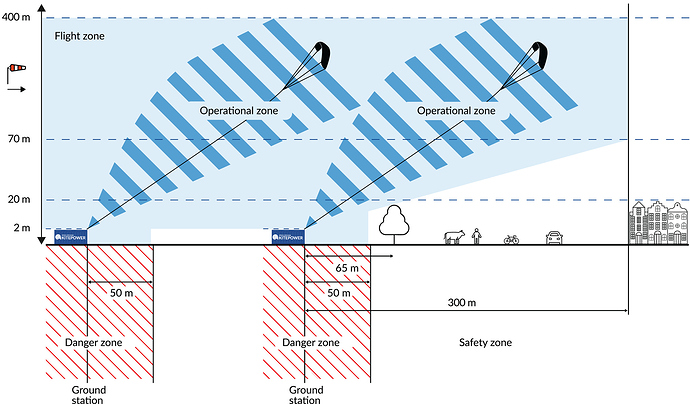Hello @rschmehl,
Thanks for the references. I will pursue in the present topic which seems to be more appropriate, Makani’s wing being a special case of crosswind flygen rigid wing, multiplying the risks. It can be a reason why both Fig.4* and 2.2.1 Zoning concept in [2] and Fig. 16.6 and 16.4.1 Spacing of Units in [3] concern “flexible wing systems” ([3] mentioning also rigid wings in the introduction, but not elsewhere) as you indicated. By this one can deduce the acceptable risk for flexible wings would not be as acceptable for rigid wing. It is a secondary point which should be more studied.
Now let us come to the main points. Fig.4 and 2.2.1 Zoning concept in [2], and Fig. 16.6 and 16.4.1 Spacing of Units in [3] are similar and both describe a sort of tilted and reversed cone delimiting the danger zone, allowing some uses under the kite flying. IMHO it is quite unrealistic:
-
Wind direction is assumed to be the same for the whole kite-farm. But various winds in direction and intensity can occur in each place of the kite-farm, leading to a likely collapse. The probabilities of such variations could be studied, combining stochastic and real wind data for example, or lead to more spacing, or even to the implementation of a single larger unity.
-
The safety issues are mainly computerized. The scheme of a farm of crosswind kites lack passive safety. The computerized management failing would likely lead to a full collapse.
-
Knowing that the tethers move fast under several tons of tension, that at a low elevation angle of an average of 30-40°, people under such tethers would likely not be accepted. I remember safety instructions from Enerkite during AWECBerlin2013 for the few kW-range wing: “nobody under the kite!”.
Currently the industry is only about preliminary testing and theoretical studies, excepted @Kitewinder.
I am afraid that my estimate is well below the security imperatives that will not fail to occur, at least for a while. Indeed a fall zone should be added.
A tether of 1 km is a little like a tower of 1 km, but in addition the rope is moving and is under high tension. So more compact designs should be studied. But it is only my opinion.
Figure 4* [2] from V. Salma, F. Friedl, R. Schmehl: “Improving Reliability and Safety of Airborne Wind Energy Systems”. Wind Energy, in production, 2019. doi:10.1002/we.2433 . Preprint accessible as pdf :
